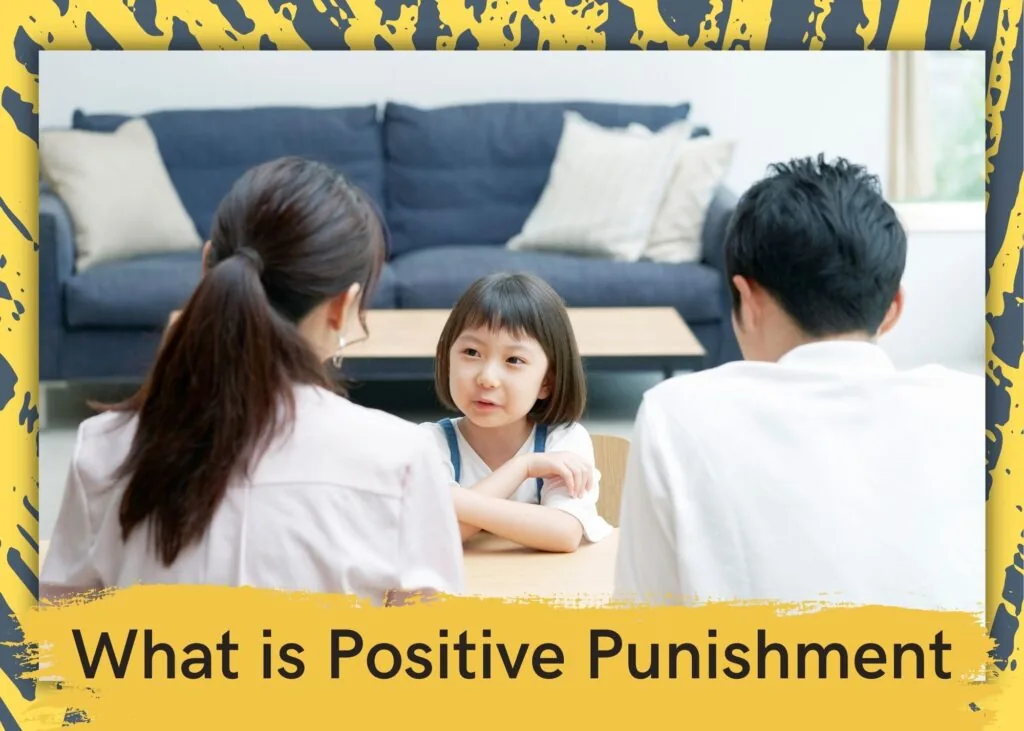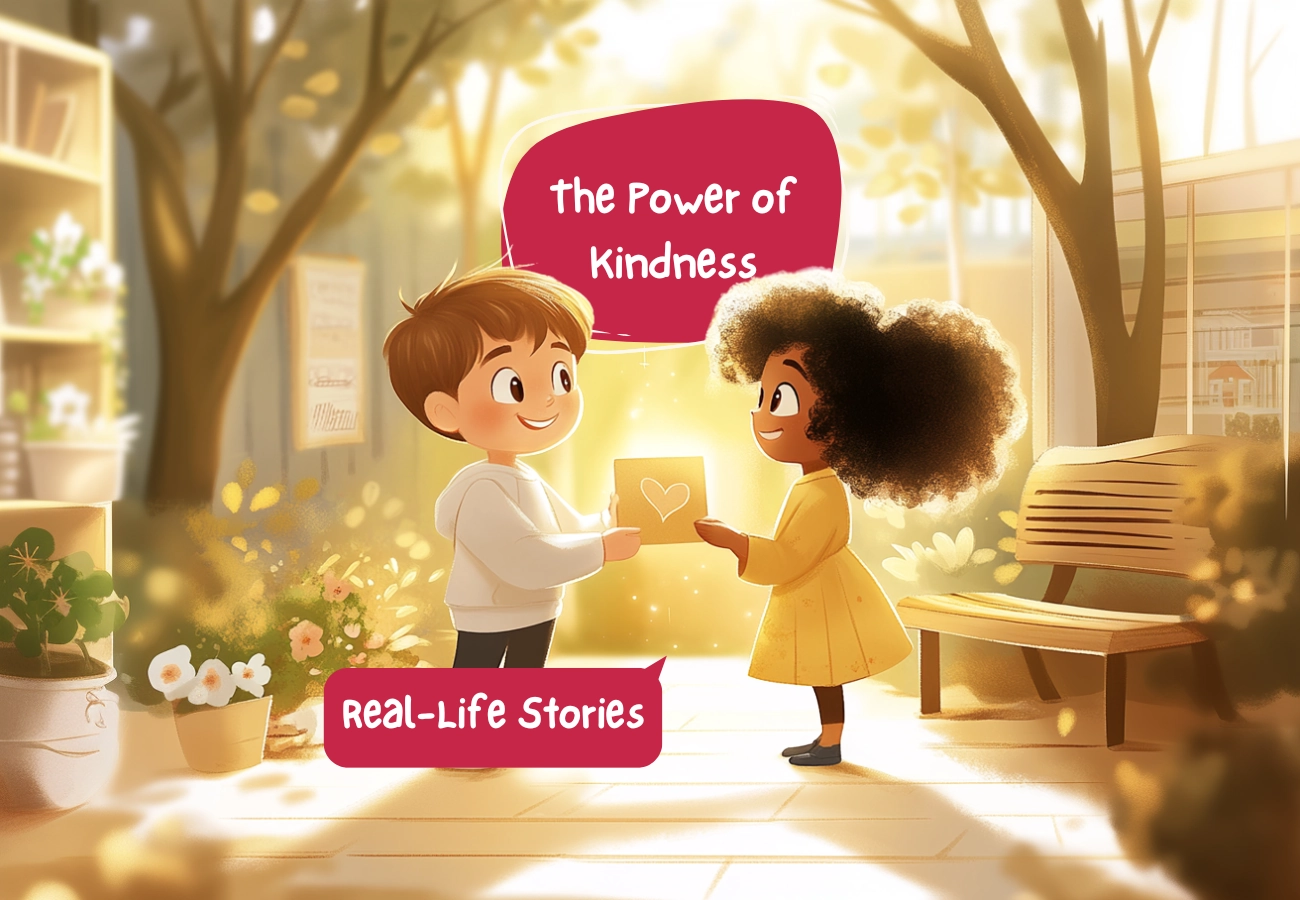What is Positive Punishment with Examples (Test Yourself)

Positive punishment is a type of influence on the other person that prevents him or her from doing undesirable actions. It’s related to Skinner’s theory of operant conditioning in positive punishment. Today, we’ll try to understand positive punishment in psychology and how to connect it with effective parenting.
It may seem slightly confusing, but positive here is not a good thing. By saying it, one implies adding something (a punishment) as a consequence of a child’s behavior (usually unwanted). The aim is to create an interconnected chain:
- bad action – bad consequences (like taking away their cell phones)
- no bad action – no bad consequences.
Here, the consequences are punishment. The kid knows that they’ll be grounded for bad behavior. Positive punishment can be both a useful tool and a cause of low self-esteem, so be mindful when integrating it into your parenting.
How Does Positive Punishment Work?
Cause-effect relations occur when a human being gains experience that follows his actions. He learns from this experience the same way a person moves his hand away from something hot when it hurts. Next time, he`ll not touch a hot object. Positive punishment aims to create the same effect – to fight off the desire to commit some actions because of foreboding negative results.
As a parent, you make the consequence happen each time your kid oversteps the rules. It’s important to punish a child right after his actions. But, don’t be rude and cruel. A positive punisher mustn’t hurt his child’s feelings. Moms and dads ought to be discerning and fair instead—especially dads because their attitude toward the kids is crucial for their self-perception and well-being. Dads, unlike moms, can be more strict and sound too demanding. They can easily offend children, even when they don`t mean to. Meanwhile, support from dads is very important for kids. Mind it.
Positive Punishment vs. Negative Punishment
Now that we`ve clarified positive punishment, let’s compare it to negative punishment. While the positive means adding something, the negative means taking something away. It also means reducing the number of rights to something. For example, an adult deprives his kid of candies due to his bad behavior. See, negative and positive punishments have the same aim – to prevent kids from doing bad things but in different ways.
Let’s take another example: a child shouting at his younger sibling. If you punish him by adding extra chores, it’s a positive punishment. On the contrary, if you punish him by banning ice cream for three days, it’s a negative punishment because you take away his ability to enjoy it. Both methods are useful unless you:
- act unfairly;
- use too strict punishment for small disobedience;
- apply it not immediately.
Be careful. From the example of disadvantaged Jamaican children, researchers prove that strict parenting can not only fail to correct the behavioral issues in kids but also trigger more severe misbehavior in the future.
Positive Punishment Examples in Real Life
Positive punishment always has unpleasant consequences that are undesirable for kids. To avoid them, they need to control their own behavior. Here are some examples.
- A child is mischievous during family dinner. His parents tell him that he must clear the table as punishment for his disobedience.
- A kid forgets to do homework. His teacher gives him extra exercise for the next time.
- A boy has deliberately scattered all the toys. Their parents force him to put them away and clean the whole room.
- A student hits his classmate, and a teacher gives him a time-out.
- A child swears at another kid. His mother makes him apologize and do some extra useful deeds, such as washing the dishes or wiping the dust.
- A kid misbehaves, and his parents yell at him. (It’s not a good way, by the way). Researchers have found that yelling may be as harmful and unpleasant as corporal punishment. Even if parents say they yell at children out of love, it’s not how to explain love to kids.
Advantages of Positive Punishment
Even though punishment always stands for something negative, it has prons as well. In psychology, it’s a way to discourage kids from committing undesirable actions. Positive punishment may involve a mild conversation to pay attention to kids` temper tantrums.
The benefits of positive punishment include the following ones:
- Children know the boundaries they should not violate. Thus, they feel relaxed and confident knowing what’s acceptable and what isn’t;
- Punishment provides children with a reason to behave well in the future. And you have to give them such an opportunity. When the punishment is over, one shouldn’t mention it (until the next case happens);
- Kids get to know that all actions have consequences. They should predict them and be aware of the responsibility they`ll encounter when violating house rules. Plus, it prepares them for adult life, where citizens should obey the law to avoid more severe punishments.
Disadvantages of Positive Punishment
- Punishment prevents kids from doing something. But when it’s over, children may behave the same way untill you apply it one more time;
- It may be perceived as an unfair punishment triggering aggression in strong-willed children. They can grow even more outrageous and resentful;
- Positive punishment may cause fear and problems with self-esteem. For example, punishment for cutting into conversations. A kid may become indecisive and timid when the situation requires him to be persuasive and interrupt other people (as a rule, in adult life);
- What to do instead of undesirable actions for a child is not always clear. Kids may be confused even if, for parents, it’s obvious. One shouldn’t only punish a kid and explain what he is supposed to do.
It’s better to combine reinforcement and punishment to guide children. In such a way, they gain a more exact understanding of their boundaries. Plus, it’s a kind of feedback on their actions:
- Good deeds – good consequences (praise, gift, etc);
- Bad deeds – bad consequences.

Which of the following is an example of Positive Punishment?
Now that you have read a lot about positive punishment, try to guess which examples represent it.
- Your kid plays with toys at your friend’s home, but he also offends a cat that lives in that room. You forbid the child to enter the room with the cat, although many toys are there to play with. So, what kind of punishment is applied here?
(Answer: It’s a negative type because you take away the opportunity to enjoy playing with new toys.)
- Your kid breaks his friend’s pencil on purpose. You make him give the victim his favorite pencil. And now?
(Anwer: It’s an example of positive punishment because a child has to fulfill an unpleasant action, which wasn’t meant until he`d broken the pencil.)
- A boy wishes to clean his desk but refuses to do it after some time. You make him fulfill the promise and clean his desk for the whole next week.
(Answer: It’s also an example of positive punishment.)
Wrapping Up
The theory of operant conditioning (or cause-and-effect relationship) presupposes such a notion as positive punishment, which means creating unpleasant consequences as a response to inappropriate behavior. The main aim is to prevent kids from doing bad things. It’s possible due to the connection between action and consequence, which becomes clear to children. They realize that the negative consequences are inevitable if they break the rules. Therefore, they restrain from triggering the very process.
Nevertheless, at the University of Central Florida, one supposes that one should weigh the necessity and possible negative effects when applying positive punishment. That`s about corporal punishment as a type of positive punishment. Thus, a 2016 review states that spanking can increase aggression in kids and boost antisocial patterns of behavior. Furthermore, 72% of adults reported in 2010`s nationwide poll that applying corporal punishment is OK. But that’s not! That’s terrible! What is positive punishment? It’s a tool to fix behavior problems, but not to increase them.
To sum it up, be mindful and use positive punishment without causing harm to your kids.
Positive punishment is a type of influence on the other person that prevents him or her from doing undesirable actions. It’s related to Skinner’s theory of operant conditioning in positive punishment. Today, we’ll try to understand positive punishment in psychology and how to connect it with effective parenting.
It may seem slightly confusing, but positive here is not a good thing. By saying it, one implies adding something (a punishment) as a consequence of a child’s behavior (usually unwanted). The aim is to create an interconnected chain:
- bad action – bad consequences;
- no bad action – no bad consequences.
Here, the consequences are punishment. The kid knows that they’ll be grounded for bad behavior. Positive punishment can be both a useful tool and a cause of low self-esteem, so be mindful when integrating it into your parenting.
How Does Positive Punishment Work?
Cause-effect relations occur when a human being gains experience that follows his actions. He learns from this experience the same way a person moves his hand away from something hot when it hurts. Next time, he`ll not touch a hot object. Positive punishment aims to create the same effect – to fight off the desire to commit some actions because of foreboding negative results.
You, as a parent, make the consequence happen each time your kid oversteps the rules. It’s important to punish a child right after his actions. But, don’t be rude and cruel. A positive punisher mustn’t hurt his child’s feelings. Moms and dads ought to be discerning and fair instead—especially dads because their attitude toward the kids is crucial for their self-perception and well-being. Dads, unlike moms, can be more strict and sound too demanding. They can easily offend children, even when they don`t mean to. Meanwhile, support from dads is very important for kids. Mind it.
Positive Punishment vs. Negative Punishment
Now that we`ve clarified positive punishment, let’s compare it to negative punishment. While the positive means adding something, the negative means taking something away. It also means reducing the number of rights to something. For example, an adult deprives his kid of candies due to his bad behavior. See, negative and positive punishments have the same aim – to prevent kids from doing bad things but in different ways.
Let’s take another example: a child shouting at his younger sibling. If you punish him by adding extra chores, it’s a positive punishment. On the contrary, if you punish him by banning ice cream for three days, it’s a negative punishment because you take away his ability to enjoy it. Both methods are useful unless you:
- act unfairly;
- use too strict punishment for small disobedience;
- apply it not immediately.
Be careful. From the example of disadvantaged Jamaican children, researchers prove that strict parenting can not only fail to correct the behavioral issues in kids but also trigger more severe misbehavior in the future.
Positive Punishment Examples in Real Life
Positive punishment always has unpleasant consequences that are undesirable for kids. To avoid them, they need to control their own behavior. Here are some examples.
- A child is mischievous during family dinner. His parents tell him that he must clear the table as punishment for his disobedience.
- A kid forgets to do homework. His teacher gives him extra exercise for the next time.
- A boy has deliberately scattered all the toys. Their parents force him to put them away and clean the whole room.
- A student hits his classmate, and a teacher gives him a time-out.
- A child swears at another kid. His mother makes him apologize and do some extra useful deeds, such as washing the dishes or wiping the dust.
- A kid misbehaves, and his parents yell at him. (It’s not a good way, by the way). Researchers have found that yelling may be as harmful and unpleasant as corporal punishment. Even if parents say they yell at children out of love, it’s not how to explain love to kids.
Advantages of Positive Punishment
Although punishment always implies something negative, it has positive aspects as well. In psychology, it’s a way to discourage kids from committing undesirable actions. Positive punishment may involve a mild conversation to pay attention to kids` temper tantrums.
The benefits of positive punishment include the following:
- Children know the boundaries they should not violate. Thus, they feel relaxed and confident knowing what’s acceptable and what isn’t;
- Punishment provides children with a reason to behave well in the future. And you have to give them such an opportunity. When the punishment is over, one shouldn’t mention it (until the next case happens);
- Kids get to know that all actions have consequences. They should predict them and be aware of the responsibility they`ll encounter when violating house rules. Plus, it prepares them for adult life, where citizens should obey the law to avoid more severe punishments.
Disadvantages of Positive Punishment
- Punishment prevents kids from doing something. But when it’s over, children may behave the same way untill you apply it one more time;
- It may be perceived as an unfair punishment triggering aggression in strong-willed children. They can grow even more outrageous and resentful;
- Positive punishment may cause fear and problems with self-esteem. For example, punishment for cutting into conversations. A kid may become indecisive and timid when the situation requires him to be persuasive and interrupt other people (as a rule, in adult life);
- What to do instead of undesirable actions for a child is not always clear. Kids may be confused even if, for parents, it’s obvious. One shouldn’t only punish a kid and explain what he is supposed to do.
It’s better to combine reinforcement and punishment to guide children. In such a way, they gain a more exact understanding of their boundaries. Plus, it’s a kind of feedback on their actions:
- Good deeds – good consequences (praise, gift, etc);
- Bad deeds – bad consequences.
Which of the following is an example of Positive Punishment?
Now that you have read a lot about positive punishment, try to guess which examples represent it.
- Your kid plays with toys at your friend’s home, but he also offends a cat that lives in that room. You forbid the child to enter the room with the cat, although many toys are there to play with. So, what kind of punishment is applied here?
(Answer: It’s a negative type because you take away the opportunity to enjoy playing with new toys.)
- Your kid purposely breaks his friend’s pencil. You make him give the victim his favorite pencil. And now?
(Anwer: It’s an example of positive punishment because a child has to fulfill an unpleasant action, which wasn’t meant until he`d broken the pencil.)
- A boy wishes to clean his desk but refuses to do it after some time. You make him fulfill the promise and clean his desk for the whole next week.
(Answer: It’s also an example of positive punishment.)
Wrapping Up
The theory of operant conditioning (or cause-and-effect relationship) presupposes such a notion as positive punishment, which means creating unpleasant consequences as a response to inappropriate behavior. The main aim is to prevent kids from doing bad things. It’s possible due to the connection between action and consequence, which becomes clear to children. They realize that the negative consequences are inevitable if they break the rules. Therefore, they restrain from triggering the very process.
Nevertheless, at the University of Central Florida, one supposes that one should weigh the necessity and possible negative effects when applying positive punishment. That`s about corporal punishment as a type of positive punishment. Thus, a 2016 review states that spanking can increase aggression in kids and boost antisocial patterns of behavior. Furthermore, 72% of adults reported in 2010`s nationwide poll that applying corporal punishment is OK. But that’s not! That’s terrible! What is positive punishment? It’s a tool to fix behavior problems, but not to increase them.
To sum it up, be mindful and use positive punishment without causing harm to your kids.
More articles

How Technology Can Empower Your Kids to Learn, Grow, and Thrive
Technology often gets a bad rap when it comes to its effects on children, including issues related to screen time, cyberbullying, and online distractions. While these concerns are valid, these misconceptions should not overshadow its incredible potential to enhance education, creativity and well-being for your child when used responsibly and mindfully. When used appropriately, technology […]

Using Alicia Ortego’s Books in the Classroom: Tips and Examples
In today’s classrooms and after-school programs across America, teachers and educators are constantly looking for effective ways to support children’s social-emotional learning (SEL). Alicia Ortego’s My Superpower books have become a favorite tool for many educators to encourage kindness, mindfulness, confidence, and other important values in young learners. Here are some real-world-inspired ways teachers and […]

The Power of Kindness: Real-Life Stories That Inspire and Transform
Kindness isn’t just a feel-good concept – it’s a force that shapes communities, builds bridges between people, and even rewires the brain for empathy and connection. From small children to grown adults, acts of kindness – both given and received – leave lasting impressions. At Alicia Ortego, we explore values like kindness through storytelling. Today, […]



